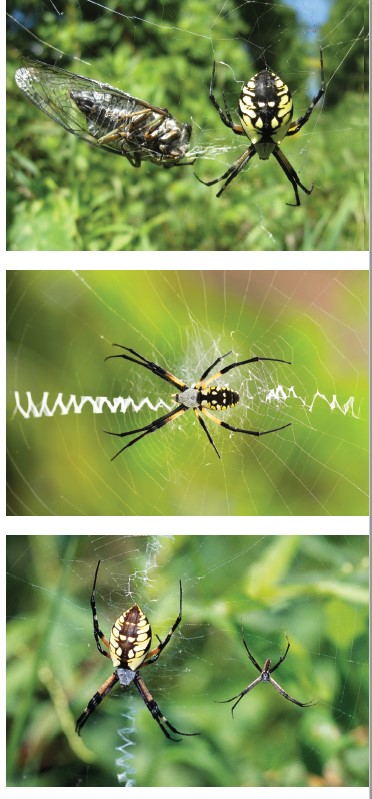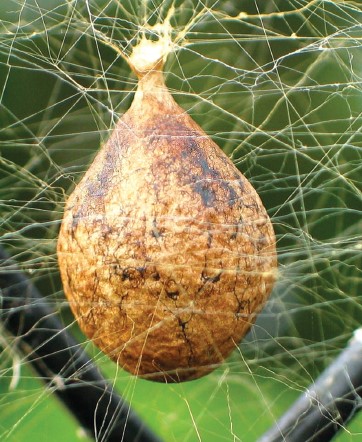Recently, our resident yellow garden spider, lovingly named “Charlotte,” had a mishap when she and her intricate labyrinth were inadvertently swept away by the removal of vines. By the following morning, she had rebuilt an entirely new replacement and was once again on the alert for flying insects that might come her way.
In general, spiders are avoided by most folks who find them creepy, off-putting, or repellent. Walking through a web may feel disgusting on your skin, but it is quite harmless and is only suspended there to enable a spider to move from one area to another that she may find more suitable. Garden spiders are not poisonous and typically, they are not aggressive and will avoid human contact unless disturbed, tampered with, or acting in self-defense.
The yellow garden spider (Argiope aurantia) is often seen in summertime gardens and yards. They were first described by a French entomologist in 1833 as being marked with black, yellow, and white on the abdomen.
Female black and yellow garden spiders sport legs that are black with red or yellow bands near the point of attachment. They will usually remain in a limited area during their lifetime and spend most of their time with their head hanging down in the mid center of the web.
Favorite prey for this yellow garden spider, considered a beneficial insect, includes geckos, green anoles, mosquitos, moths, wasps, and mud daubers. They will also ensnare flies, moths, and mosquitoes.
 The black and yellow Argiope spider is one of the most conspicuous species called an orb-weaver, which means it spins its web in a spiraling circle with bright white zigzagging forms hanging vertically in the center. These webs are snares for flying insects; in areas of abundant prey the spiders can grow inches in diameter, provoking awe and unease in those who come across one on a wooded trail.
The black and yellow Argiope spider is one of the most conspicuous species called an orb-weaver, which means it spins its web in a spiraling circle with bright white zigzagging forms hanging vertically in the center. These webs are snares for flying insects; in areas of abundant prey the spiders can grow inches in diameter, provoking awe and unease in those who come across one on a wooded trail.
Constructing a web is a remarkable undertaking. Beginning with a stable initial point such as a grass stem or a window eave, the female lifts her abdomen to discharge several strands of silk from her spinnerets that merge into one thread onto the existing base she has begun fabricating. She will then begin to add bridge lines and scaffolding for the framework, and next comes the hub made with additional threads following a spoke-like design.
The sticky silk that she uses for the spiraling strands will actually catch her prey. Once she completes this part of the construction, she will devour the center hub and its framework.
One final step to completion will be the auxiliary stabilimentum, a zigzag pattern thought to provide structural stability. Only spiders that are active in the daytime use these stabilimenta.
The black and yellow male is smaller and less colorful than the female. He will die shortly after mating and will be eaten by his mate, and for these reasons he is seen less often.
After finding a female in her orb, the male will set up a small web of his own in or on an isolated portion of the female’s web. From this position, presumably a sheltered spot, he will court her by plucking and vibrating her web. She finds this exciting and stimulating and moves quickly to capture him.
 The black and yellow Argiope female breeds once a year. She lays her eggs on layers of silk for protection usually in the cover of night, forming the sheet into balls and suspending it near the center of the web for protection from predators.
The black and yellow Argiope female breeds once a year. She lays her eggs on layers of silk for protection usually in the cover of night, forming the sheet into balls and suspending it near the center of the web for protection from predators.
Each spider will produce several sacs with nearly a thousand eggs inside. The young spiders exit the sacs in the spring, with some remaining in the garden area while others will be carried away on a strand of silk to another suitable area or garden.
The territory of the Argiope is widespread across Galveston County. They are the largest spider in the Galveston-Houston region, with females growing up to 1⅛” and males just over ¼”.
These spiders are generally harmless but can be a nuisance if building over-sized webs in places that may be inconvenient for humans. Also called a “golden orb-weaver,” their orb webs can span more than two feet in diameter.
Despite this imposing presence, the black and yellow Argiope is not aggressive but in fact beneficial to our environment.
Other Spiders Common to Our Area
Black Widow Spider
-attacks only in self-defense
-hour-glass-shaped marking on abdomen
-poisonous venom can be fifteen times stronger than a rattlesnake
-symptoms can include nausea, muscle aches, and difficulty breathing
-female black widows are about ½”-inch long
-males are about half the size of females, lighter in color, with red or pink spots on their backs
Brown Recluse Spider
-dark violin pattern on a brown or tan body
-six eyes instead of the eight seen on other spiders
-the bite may not be felt immediately but there will be later effects
-may cause severe lesions to the skin but not necrosis (tissue death)
-rarely aggressive, tends to attack only if threatened
- measure ¼”- ½”
Jumping Spider
-often mistaken for a black widow spider
-may be black, brown, tan, or gray with white, blue, red, or green markings
-seen almost exclusively in day light hours
-do not build webs but when jumping, they emit a silk dragline to ride to safety
-well-developed eyesight; they use their vision to study and track their prey
-these are most likely the web that you encounter on your stroll through the yard
Wolf Spider
-will chase and leap on prey like wolves (hence the name)
-hairy with a camouflage appearance
-orange-brown coloring with black and gray splotches or stripes
-only bites if provoked; bite can be quite painful but not lethal
-body size ranges from ¼” to more than ½”
-largest species can have legs up to 3” or more and thus may resemble a tarantula